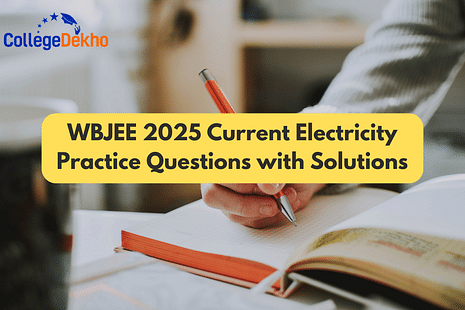
WBJEE 2025 Current Electricity Practice Questions with Solutions: Current Electricity is a fundamental chapter in intermediate Physics syllabus. The chapter is also a part of WBJEE syllabus. The WBJEE 2025 exam paper is expected to have a total of 2-3 questions (approximately 6% of the total syllabus weightage) from this chapter. Therefore, to score full marks in this section, you must be adept with the WBJEE Current Electricity sample questions. Current Electricity being an important chapter in the WBJEE 2025 Physics syllabus PDF covers various topics, such as Ohm's Law, Electrical Resistance, Ohmic and Non Ohmic Conductors, Electrical Energy & Power etc. Since these topics are majorly based on numerical solutions and application of various laws and theories of Physics, you must solve practice questions for WBJEE 2025 Current Electricity while studying these. Over the years, there has not been any major shift in the question pattern, and so, based on the past few years' question paper anlaysis, we have provided a series of WBJEE 2025 Current Electricity practice questions with solutions in this article.
Also Check -
WBJEE 2025 Probability Practice Questions with Solutions
Quick Links:
| WBJEE 2025 Exam Pattern | WBJEE 2025 Exam Date |
|---|
List of WBJEE 2025 Current Electricity Sub Topics for Exam Preparation
The chapter on Current Electricity in WBJEE is important and to score well in the exam, you must be well aware of all the topics covered in the WBJEE 2025 syllabus PDF . The table below features the complete list of topics from which WBJEE Current Electricity sample questions will be asked.
Chapter | Sub Topics |
|---|---|
Current Electricity | Electric current & conductor |
Drift velocity mobility & their relation with electric current | |
Ohm's law | |
Electrical resistance | |
Ohmic and non-Ohmic conductors | |
Electrical energy & power | |
Carbon resistors | |
Colour codes | |
Combination of resistances | |
Temperature dependence of resistances | |
Electric cell | |
Emf and internal resistance of an electric cell | |
Potential difference | |
Combination of cells | |
Secondary cells, (introductory) Kirchoff’s laws of electrical network | |
Simple applications | |
Principle of Wheatstone Bridge | |
Metre bridge and potentiometer and their uses | |
Thermoelectricity | |
Seebeck effect | |
Peltier effect | |
Thermo emf |
Quick Links:
| Best WBJEE Coaching Institutes in India 2025 | WBJEE Previous Year Question Papers |
|---|---|
| WBJEE Sample Papers | Best Books for WBJEE 2025 Exam Preparation |
WBJEE 2025 Current Electricity Expected Weightage
The marks weightage makes it easier to comprehend how many questions from the Current Electricity might be asked and how many marks you can score by solving the amximum practice questions for WBJEE 2025 Current Electricity. You can get an idea about the WBJEE Current Electricity marks weightage and expected number of questions from the table below.
Topic | Expected Number of Questions | Expected Weightage |
|---|---|---|
Current Electricity | 2-3 | 7% |
WBJEE 2025 Current Electricity Practice Questions Practice Questions with Solutions
The WBJEE 2025 Current Electricity practice questions with solutions serve as an excellent preparation tool for exam preparations. These questions can be used to evaluate knowledge and exam readiness as well as to revise the core concepts. View the following crucial WBJEE 2025 Current Electricity practice questions hand-picked by our experts based on the previous years' paper analysis.
Q.1 A battery of e.m.f. E and internal resistance r is connected to an external resistance R the condition for maximum power transfer is:
a) r < R
b) r > R
c) r = 1/R
d) r = R
Correct Answer: d) r = R
Solution:
Current in the circuit I = E/R+f
Power delivered to the resistance R is
P = I 2 R = E 2 R/(R+r) 2
It is maximum when dP/dR = 100
dP/dR = E 2 [(r+R) 2 -2R(r+R)/(r+R) 4 ] = 0
or (r+R) 2 = 2R(r+R)
or r = R
Q.2 A thin wire of resistance 4 Ω is bent to form a circle. The resistance across any diameter is:
a) 4 Ω
b) 2 Ω
c) 1 Ω
d) 8 Ω
Correct Answer: c) 1Ω
Solution:
The resistance of the total wire is 4Ω
The two semicircles are connected in parallel between the two ends of the diameter.
For two resistors in parallel, the effective resistance Reff is given by:
1/R eff = 1/R 1 + 1/R 2
Here, R 1 = R2 = 2Ω
Substituting:
1/R ef = 1/2 + 1/2 = 2/2 = 1
Therefore:
R eff = 1Ω
Q.3 Six wires, each of resistance r, are connected so as to form a tetrahedron. The equivalent resistance of the combination when current enters through one corner and leaves through some other corner is:
a) r
b) 2r
c) r/3
d) r/2
Correct Answer: d) r/2
Solution:
Six wires of resistance r each form a tetrahedron. For current entering at vertex A and leaving at B, symmetry ensures equal current distribution. Using Kirchhoff’s laws and symmetry, the equivalent resistance between A and B is:
R eq = r/2
Q.4 Two equal resistances, 400 Ω each, are connected in series with a 8 V battery. If the resistance of first one increases by 0.5%, the change required in the resistance of the second one in order to keep the potential difference across it unaltered is to:
a) Increase it by 1 Ω
b) Increase it by 2 Ω
c) Increase it by 4 Ω
d) Decrease it by 4 Ω
Correct Answer: b) Increase it by 2 Ω
Solution:
In series combination, R = R 1 + R 2
The same current will pass in R 1 and R 2 . According to the question, R 1 is increased by 0.5%.
Therefore, increment in the resistance:-
0.5/100 x 400 = 0.2Ω
So to keep the potential unchanged in the second resistance the change required will 2.0 Ω increment
Q.5 If all the cells have negligible internal resistance, what will be the current through the 2 Ω resistor when steady state is reached?
a) 0.66 A
b) 0.29 A
c) 0 A
d) 0.14 A
Correct Answer: c) 0 A
Solution:
Identify the configuration of the 2Ω resistor (series or parallel) and the total circuit resistance.
Using Ohm’s law ( I = V / R ), calculate the current based on the voltage of the power supply and the equivalent resistance.
If the 2 Ω resistor is in a branch with a capacitor, no current flows through it in steady state because the capacitor blocks the current. Hence, the current through the
2Ω resistor is: 0A
Q.6 Two wires of same radius having lengths l1 and l2 and resistivities and p1 and p2 are connected in series. The equivalent resistivity will be:
a) p 1 l 2 +p 2 l 1 /p 1 +p 2
b) p 1 l 1 +p 2 l 2 /l 1 +l 2
c) p 1 l 1 - p 2 l 2 /l 1 - l 2
d) p 1 l 2 +p 2 l 1 /l 1 +l 2
Correct Answer: b) 1 l 1 +p 2 l 2 /l 1 +l 2
Solution:
R=pl/A
where, p = resistivity
l = length of the resistance wire
a = area of cross section
When the wires are connected in series, then
R = R 1 + R 2
R = p 1 l 1 /A 1 + p 1 l 2 /A 2
= p 1 l 1 /A + p 2 l 2 /A
Therefore, (A 1 = A 2 )
p eq = resistivity of combination
l = l 1 + l 2
A = A
Thus, p eq l 1 +l 2 /A = p 1 l 1 + p 2 l 2 /A
p eq = p 1 l 1 }p 2 l 2 /l 1 +l 2
Q.7 Four resistors, 100 Ω, 200 Ω, 300 Ω, and 400 Ω are connected to form four sides of a square. The resistors can be connected in any order. What is the maximum possible equivalent resistance across the diagonal of the square?
a) 210 Ω
b) 240 Ω
c) 300 Ω
d) 250 Ω
Correct Answer: a) 210 Ω
Solution:
R series1 = R 3 + R 4 = 300 + 400 = 700Ω
The equivalent resistance across the diagonal is given by:
1/R eq = 1/R series1 +1/R series2
Substitute the values:
1/R eq = 1/700+1/300
Simplify:
1/R eq = 300+700/700x300 = 1000/21000
R eq = 21000/1000 = 210Ω
Q.8 What will be current through the 200 Ω resistor in the given circuit, a long time after the switch K is made on?
a) Zero
b) 100 mA
c) 10 mA
d) 1 mA
Correct Answer: a) Zero
Solution:
A long time after the switch K is closed, the capacitor in the circuit becomes fully charged and behaves like an open circuit in a steady state. If the 200Ω resistor is in series with the capacitor, no current flows through it since the capacitor blocks the current. Thus, the current through the 200Ω resistor is zero in a steady state.
Q.9 An electric bulb, a capacitor, a battery and a switch are all in series in a circuit. How does the intensity of light vary when the switch is turn on?
a) continues to increase gradually
b) gradually increases for sometime and then becomes steady
c) sharply rises initially and then gradually decreases
d) gradually decreases for sometime and then gradually decreases
Correct Answer: c) sharply rises initially and then gradually decreases
Solution:
Initially, there will be no voltage drop across the capacitor, so the intensity of the bulb will rise sharply and gradually voltage drop across the capacitor will increase as a result voltage drop across the bulb decreases, so the intensity of the bulb will decrease.
Q. 10 Consider the circuit shown in the figure where all the resistances are of magnitude 1 k Ω. If the current in the extreme right resistance X is 1 mA, the potential difference between A and B is:
a) 34 V
b) 21 V
c) 68 V
d) 55V
Correct Answer: a) 34 V
Solution:
All resistances are 1kΩ
Current through the extreme right resistance X is 1 mA
We need to find the potential difference between points A and B.
The extreme right resistor X has a current of 1mA, so the voltage drop across it is:
V x = I ⋅ R = (1mA) (1kΩ)=1V
Calculate the Voltage Across A and B:
V AB =34V
The potential difference between A and B is: 34V
Quick Links:
| WBJEE 2023 Question Paper PDF | WBJEE 2022 Question Paper PDF | WBJEE 2021 Question Paper PDF |
|---|
Related Articles
| WBJEE 2025 Units and Measurement Practice Questions with Solutions | WBJEE 2025 Laws of Motion Practice Questions with Solutions |
|---|
We hope that this post on the WBJEE 2025 Current Electricity Practice Questions with Solutions was helpful and informative. For the latest news and exam updates stay tuned to CollegeDekho!
Are you feeling lost and unsure about what career path to take after completing 12th standard?
Say goodbye to confusion and hello to a bright future!

Was this article helpful?





















Similar Articles
KCET Physics All Formulas PDF
Is GUJCET only for Engineering?
KCET 2026 OMR Sheet – Sample (PDF Download), Instructions, Carbon Copy
GUJCET 2026 Application Form Correction: Check Process, Dates, Here
KCET Login 2026 - User ID, Application Number, Password, Steps to Retrieve
Documents Required to Fill KCET Application Form 2026 - Image Upload Process, Specifications